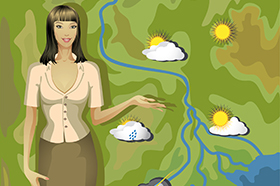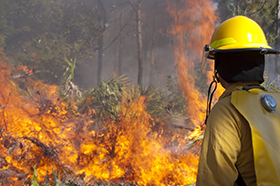Marysville is located on the Steavenson River in the picturesque Yarra Ranges, around 100kms north east of Melbourne. The journey to Marysville offers a wonderful entr'acte to the natural attractions of the region. After following the Maroondah Highway through Lilydale and Healesville the road climbs further along narrow, winding roads to the notorious but scenic Black Spur. Today the road is well maintained with barriers along the road shoulders preventing accidental plunges down into the steep gullies below.
Take the time to stop at the Fernshaw Picnic Ground before climbing the spur or take in the views from the summit at Dom Dom Saddle picnic ground. Continue along the highway and take the turn off after Narbethong to Marysville and Lake Mountain.
The Upper Goulbourn and Woods Point goldfields attracted scores of people from Melbourne and beyond in the 1860's. Marysville was established in 1863 as a convenient stopping place along the old Yarra Track. The Marysville Post Office was opened in 1865 and public institutions such as the school and library were soon to follow. It was named after Mary Steavenson, the wife of John Steavenson who was the Assistant Commissioner of Roads and Bridges at that time. As trade increased along the Yarra Track, the road was improved to cater for the coaches and all-weather drays.
The slopes of the surrounding ranges are covered with towering and dense hardwood forests of Mountain Ash (Eucalyptus regnans). Although access to these proved extremely challenging, the valuable timber soon became a prime source of industry in the area. Horse drawn tramways were used to cart the timber to the mills which opened in the area in the decades from around 1901 – 1950. Today, although the mills are long gone, traces of them and the tramways can still be found dotted around the area. Large areas of the local forests were set aside more than 100 years ago as catchment areas for Melbourne’s pristine water supply or have become national parks or state forests.
As early as the 1920's Marysville had become a very popular tourist destination, particularly with honeymooners. It’s proximity to Melbourne and the railway line at nearby Healesville made it very accessible.
The Marysville Tourist and Progress Association was founded in 1924 to promote the town and its' beautiful scenic attractions. Many walking trails were forged through the forests and fern gullies including one to the already popular Steavenson Falls.
By 1920 there were already 12 guest houses in the town with the Cumberland Guest House perhaps being the most well known. Since that time, tourism has remained the main industry in the region. In summertime the Yarra Ranges National Park and other nearby parks and forests attract bushwalkers, mountain bike riders, campers and scenic drivers. Several large reservoirs in the district play the dual role of storing water from the catchments and providing spectacular outdoor 'play' areas for boating, fishing and water-skiing.
In winter, the nearby Lake Mountain Alpine Resort comes alive with a world-class ski resort. Here cross-country skiing, tobogganing and snowboarding are very well catered for. Marysville is well set up to cater for the winter tourist trade with a range of accommodation options and ski-hire firms.
Being in the midst of such a dense forest of eucalypts puts Marysville and the nearby towns at the mercy of bushfires in the hot months every summer especially in years of drought. Since it was founded, the town has had several close shaves with fire. During the Black Friday fires of 1939, the flames could be seen from the town on the slopes of nearby Mount Gorden across to Mount Margaret but only one house was destroyed.
The nearby town of Narbethong was not so lucky and it was completely destroyed. In 1983 the Ash Wednesday fires that devastated many parts of south eastern Australia again came close but just missed the town.
On 7 February 2009, Victoria's Black Saturday bushfires developed rapidly and raged right through Marysville and burned it almost entirely to the ground with 40 people losing their lives. Many could not evacuate in time and were forced to seek emergency shelter in Gallipoli Park in the town centre. The town itself was declared a crime scene and was closed to all except emergency personnel until well into March.
It took some time before residents were finally able to return and rebuild their homes and their lives. Some businesses re-opened within months in tin sheds but various circumstances meant that some families could not rebuild for a few years. It is a testament to the resilience of the locals that Marysville is now a bustling tourist town again, gardens are flourishing and new houses have popped up on the sites of the old. It will take a long time for the scars on the environment and in people's hearts will heal but new life and new growth have created a vibrancy in the air similar to that of the pioneering years.



